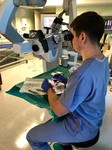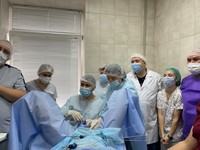

















What is cervical cancer?
Cervical cancer is a malignant tumor that develops in the cells of the cervix, the lower part of the uterus that connects to the vagina. It is one of the most common types of cancer among women worldwide (currently ranks 4th), but thanks to screening and vaccination against the human papillomavirus (HPV), it can be effectively prevented and treated in its early stages.
Causes and Risk Factors
The main risk factor for cervical cancer is infection with human papillomavirus (HPV). Other risk factors include:
- Early onset of sexual activity: Increases the risk of HPV infection.
- Multiple sexual partners: Compared to having one partner, the risk doubles with two partners and triples with six or more partners.
- Smoking: Reduces immunity and promotes the development of cancer.
- Weakened immunity: HIV or other conditions that weaken the immune system.
- Prolonged use of hormonal contraceptives: May increase the risk of the disease.
Symptoms
In the early stages, cervical cancer may be asymptomatic. However, as it progresses, the following symptoms may appear:
- Abnormal vaginal bleeding (between periods, after intercourse, or after menopause).
- Pain during sexual intercourse.
- Discharge with an unpleasant odor.
- Pelvic pain.
Diagnosis
Several methods are used to diagnose cervical cancer:
- Pap test (cytological smear): Helps detect precancerous changes in cervical cells.
- HPV test: Determines the presence of human papillomavirus.
- Colposcopy: Examination of the cervix using a special microscope.
- Biopsy: Taking a tissue sample for examination under a microscope.
Treatment
Treatment methods depend on the stage of cancer and the patient's overall health. The main methods include:
- Surgery: Removal of cancerous tissue (cervical conization, cervical amputation, sometimes complete removal of the uterus).
- Radiation therapy: Used to destroy cancer cells.
- Chemotherapy: Can be used alone or in combination with radiation therapy.
- Targeted therapy: The use of drugs that act on specific molecules of cancer cells.
Prevention
There are several ways to reduce the risk of cervical cancer:
- HPV vaccination: Protects against the most dangerous types of the virus.
- Regular screening: Pap test and HPV test help detect precancerous changes at early stages.
- Safe sexual practices: Use of condoms and limiting the number of sexual partners.
- Quitting smoking: Reduces the risk of cancer development.
Cervical cancer is a serious disease, but thanks to modern diagnostic and treatment methods, the chances of recovery can be significantly increased. It is important to have regular check-ups and HPV vaccination. Take care of your health and take care of yourself!





